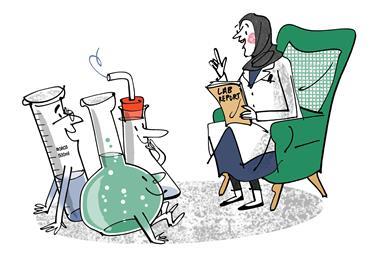I am in complete agreement with the views expressed by Huw Pritchard in his letter (Chemistry World, June 2005, p31).
In my first chemistry lesson in 1961 the master was talking about the action of metals on water. He illustrated his talk by dropping pieces of sodium and potassium into a bowl of water. I was fascinated by the result.
All the lessons up to O level were accompanied by demonstrations. Such demonstrations were no longer necessary during A level courses as, by that stage, we were all fascinated by the subject. I am not aware of any laboratory accidents occurring, since from an early stage, we were taught about the hazards of common chemicals, and how to handle them in a safe manner.
About 10 years ago I studied for a higher national certificate in chemistry. I was amazed by the lack of basic chemical knowledge shown by many of the students, and their lack of knowledge about the safe handling of chemicals.
Though I am a consultant pathologist, and chemistry is of no relevance to my medical work, I still retain an interest in the subject, and continue to study it in my spare time. I wonder how many students who study chemistry today will be able to make the same remark in 40 years time.
C A J Brightman
By e-mail
Huw Pritchard raises interesting points in his letter concerning the decline in chemistry education (Chemistry World, June 2005, p31).
After 30 years’ industrial research, I took early retirement, qualified as a teacher, and worked part time at a local university college where most of my students were ’mathematically challenged’.
I soon recognised that mathematics had been a cloak, which in many ways had obscured the real significance of many concepts during my student years in the 1960s. I could recite all the equations, and use them, but how could I explain the concepts to people who couldn’t use mathematics?
I came up with ideas that were non-quantitative but explanatory. For example, anions of strong and weak acids were likened to pensioners and children scavenging for packets of bubble gum (hydrogen ions).
Free energy was described as that left after the devil had taken his share to increase disorder during the process. I felt that it was far better to give an understanding of the principles, which students would remember, than to make them learn confusing equations.
I wonder how many other people have had the same experience as I had, learning the mathematical tools but losing the beauty of the reality behind it all in the process.
M K Baldwin FRSC
Kent, UK
Although 2004 saw a slight increase in the number of students admitted to chemistry degrees, there has been a marked decline over the last few years.
The numbers of pupils studying A level chemistry has always fluctuated but in the school where I taught I saw numbers halved over the period 1996 to 2004. Of these, about one per year proceeds to a chemistry degree of some sort. The others use it as a route to biology or medically related degrees.
In my opinion, schools do not sort the ’sheep from the goats’ early enough with the result that good pupils lose confidence and suffer peer pressure to shun science.
Many schools follow mixed science courses that provide variety but not continuity. Thus pupils have little idea of the coherence of chemistry which seems complex in comparison with stand alone concepts in physics and biology.
The teaching of science at Key Stages 2, 3 and 4 constantly revisits concepts. While this helps some pupils to absorb ideas, it generates resentment of the type ’we’ve done all this twice before’. Practical work tends merely to be illustrative, not explorative. Pupils often know the expected observation before they start.
Is the comprehensive system at the root of the problem? The answer is no. I don’t argue for a wholesale return to selection, but I do argue for the early identification of pupils who have the intellectual skills to pursue chemistry and to teach them the subject separately and coherently.
E Franklin
Bristol, UK
I was quite shocked by your editorial suggesting more nuclear power stations (Chemistry World, June 2005, p2). Less carbon dioxide, granted, but at what cost to our grandchildren and theirs?
The time to think about nuclear power is after we have solved the waste problem, rather than burying it for future generations. I am aware that wind power will not fill the gap, but there is a way out.
Born and bred on the Essex coast, I am aware that one thing never stops - the tide. The clouds may block out the sun, the wind may drop, but the moon continues to exert its gravitational pull on the earth and the tides rise and fall incessantly. There is the answer to the energy problem.
J Dowding MRSC
Colchester, UK
I was interested to read a write up discussing the ’world’s smallest test tube’ (Chemistry World, December 2004, p7).
It states that the carbon nanotube used by David Britz and colleagues in their paper (Chem. Commun., 2005, 37) was ’verified in the Guinness Book of World Records as the world’s smallest test tube’. The report describes the dimensions of the nanotube: a diameter of 1.2nm and a length of 2m m giving it a volume of 10-21L [originally claimed as 10-24L, the volume was corrected in Chemistry World, January 2005, p30 - Ed].
Work in my group reported much smaller capsules as test tubes. The dimensions are about 1 ? 2nm (about a thousand times smaller) with a volume calculated to be in the order of 10-25L.
J Rebek
La Jolla, US
Andrei Khlobystov, Nottingham University, UK, and David Britz, Oxford University, UK, respond:
In his comment Professor Rebek is correct that the void inside these capsules is smaller than the internal volume of carbon nanotubes.
Nature created even smaller voids, which can be found, for example, as interstitial spaces between the molecules in molecular crystals, or inside the carbon cage of Buckminster fullerene C60. However, there is a big topological and hence physical-chemical difference between a ’test tube’ and a ’capsule’.
The tube has a tubular shape and has one or two ports of entry, whereas the capsule is sealed. In order to put molecules into the capsule it has to be dismantled and re-assembled again, and to retrieve the product from the capsule it has to be taken apart.
In his publications, Rebek talks about a problem of ’product inhibition’ of chemical reactions in capsules and a problem of product release, which could pose difficulties in the development of applications for these structures.
With tubes molecules are free to enter, react inside and leave. The nanotube resembles a miniature version of a continuous flow reactor. The tube itself remains structurally intact during the whole process, thus the nanotube is acting as a genuine chemical reactor. Professor Rebek’s work on supramolecular capsules is certainly more mature than work on reactions inside carbon nanotubes. Both fields can be advanced by understanding techniques and material systems used in the other.
The occurrence of global warming and associated climate change have been established beyond doubt and are constantly confirmed by the observation of many phenomena but the assumption that these effects have been caused by human activity seems to be based on continued assertion rather than evidence (Chemistry World, June 2005, p2).
General reading of the literature suggests that many investigations have allowed the estimation of the temperature of the earth at various periods. When these diverse estimates are assembled together, there seems to be a broad pattern of increasing temperatures, starting sometime in the Cretaceous, more than 65 million years ago.
Superimposed on this broad trend are some peaks and troughs, showing that the temperature of the earth has sometimes increased and sometimes decreased. One of the increases appears to have started just before the beginning of the industrial revolution and is continuing today.
The standard of comparison for modern atmospheric carbon dioxide concentrations or average temperatures is an arbitrary year in the 18th century, which may give a fortuitous but misleading result. A span of a couple of centuries is a long time in human affairs but it is inadequate for the evaluation of many geological processes.
This enormously important topic seems to have been abandoned to pressure groups, political opportunists and bandwagon jumpers and I cannot recall having seen one article devoted to the verification of the connection between global warming and human activity.
Also none of the computer models I have seen described has considered what would happen to the carbon dioxide concentration in the atmosphere if the earth’s temperature increased independently.
Such an article would surely constitute a most important contribution to the scientific debate.
P M Dryburgh FRSC
Edinburgh, UK
Your otherwise excellent article on measuring concentrations of tropospheric trace gases and pollutants from space (Chemistry World, May 2005, p40) was sullied by the final remark that ’the data is beginning to be delivered, albeit at considerable expense’. Expensive for whom and in relation to what?
Clearly satellite measurements are expensive in comparison say to measurements made at a ground site - or to a sparse network of ground stations, scattered over the globe, such as those in the Global Atmospheric Watch network. But surely the real comparison and competition is with other satellite missions.
As a recent report - The integrated global atmospheric chemistry observations theme - indicated: to monitor the deteriorating state of the atmosphere, it is essential to establish a research and monitoring system for the chemistry of the atmosphere, consisting of satellites, ground stations and aircraft-based measurements, linked to a comprehensive modelling system.
Given the choice between a combination of esoteric physics and popular astrophysics, or the understanding and monitoring of the chemical health of the atmosphere, I know where I would like my money put please.
P Borrell CChem, FRSC
Newcastle-under-Lyme, UK












No comments yet